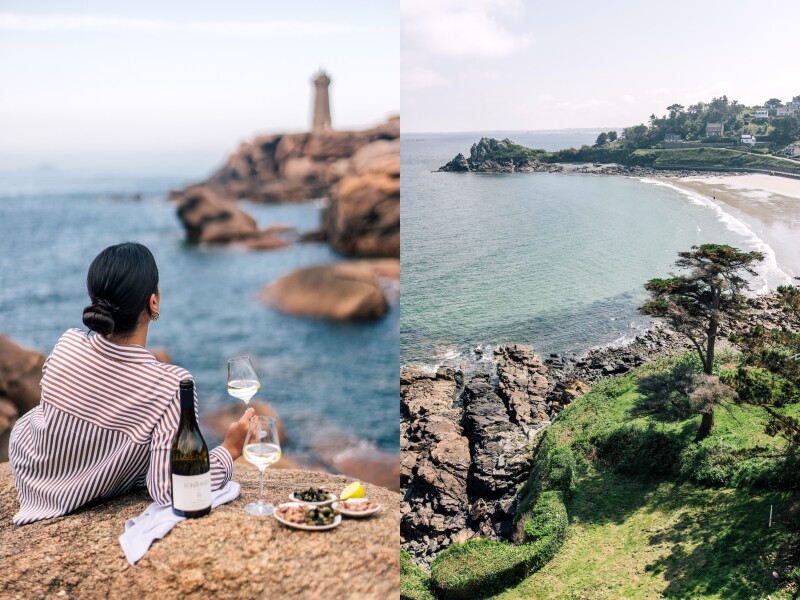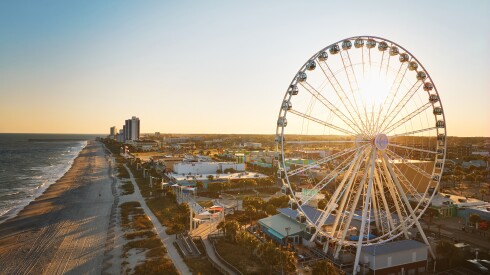Any idea how many international tourists visited France last year? One hundred million. You read that right: 100 million people poured into a country whose population is 68.6 million and is smaller than Texas. And it wasn’t just the 2024 Olympics that brought visitors; roughly the same number of people came in 2023.
That might not come as the best news to travelers hoping to visit the European country. After all, vacations shouldn’t be about competing for a waterfront dinner reservation or a view during a hike. But there are still places in France where you can avoid the hordes of other travelers.
In these five towns, including three coastal spots, you won’t have to elbow your way through the crowds. You’ll also find reasonably priced local wine, picturesque town squares, quiet stretches of beach, and a medieval castle. Here’s where to see the best of France in a more relaxed way.
Instead of St. Malo . . .

Perros-Guirec sits on the Côtes-d’Armor, which takes its name from the French word for “coast” and the Breton words for “by the sea” (ar mor) .
Photo by Tiphaine Caro/Courtesy of Les Bassans
Go to Perros-Guirec
Between people coming on the ferries from England, day-trippers from Paris, and visitors staying the night to see Mont Saint Michel, St. Malo can get packed. Instead, head to the seafront town of Perros-Guirec on the same Brittany peninsula, but further west in the Côtes-d’Armor region. Here you’ll find striped shirts aplenty, tureens of mussels gathered only a few hundred feet away, rocky beaches, and pleasant temps that top out in the upper 70s.
What to do: The town is proudly low-key, eschewing gimmicky attractions in favor of relaxed, refreshing ocean activities. You’ll find locals picnicking on the beach, sailing and kayaking, and taking in sea views along the Customs Officers’ Trail, a waterfront path cleared in 1791 to combat smuggling. For a unique day trip, take a boat around the Sept-Îles archipelago, four miles off the area’s Pink Granite Coast. The archipelago is known for its 27 bird species, among them puffins, and you may even see dolphins on the way. The boat stops at Île aux Moines, where you can meander the coastal paths down to a small park filled with rabbits.
Where to stay: Opened in June 2025 in an early 20th-century stone villa, Les Bassans has 25 ocean-view rooms done up in beachy beige and white. Interiors feature light wooden furniture, ceramics, and tile from local artisans, and the hotel has an energy-monitoring system to reduce its consumption. Les Bassans is five minutes from the beach but, given how bracing the Atlantic is, you’ll be glad for the ocean-facing hot tub.
Instead of Biarritz . . .

Small grassy dunes lead down to Hossegor’s golden-sand beaches, where surfers try to catch waves and swimmers brace for the icy Atlantic.
Photo by sylv1rob1/Shutterstock
Go to Hossegor
The Atlantic coast of southwest France is a favorite of surfers who come to ride its big waves and then enjoy just-caught seafood and white wines from the Occitanie and Pyrenees regions. Surf-capital Biarritz can get jam-packed in summer, but 22 miles north is the smaller surf town of Hossegor. Here you’ll find waves for surfers, a placid lake for paddleboarding or swimming, a handful of restaurants where you can sip rosé and slurp oysters, and—as in all French towns—a few boulangeries selling baked treats.
What to do: There are a dozen surf schools where you can try your hand at riding the waves. For a water sport that requires less core strength, the Yacht Club Landais rents out kayaks, paddleboards, and paddle boats and offers paddleboard yoga classes.
Where to stay: With its fragrant pines, white exterior with forest green trim, and wooden decks, the 1930s art deco villa that houses Les Hortsensias du Lac suggests the USA more than southwest France. Its designers have certainly pulled inspiration from the States; the hotel’s owners describe its 25 rooms as having “a laid-back spirit similar to the Hamptons’ surf hotels.”
Instead of the Côte d’Azur . . .

Hike from Niolon to Ensues-la-Redonne and you’ll pass gorgeous vistas and bobbing boats.
Photos by M. Giordano (L) and M. Di Duca (R)
Go to the Côte Bleue
We’ll be the first to tell you: The vibe of the Côte Bleue is nothing like that of the Côte d’Azur. There are no see-and-be-seen restaurants here, no buzzing nightlife, or seafood towers topped with sparklers. But if you’re after calm little bays where you can swim in the warm, azure waters of the Mediterranean without dodging elbows, take the train west from Marseille instead of east. Fifteen minutes later, the tracks curve along the dramatic 39-mile coastline, revealing the turquoise sea and rocky limestone cliffs known as the calanques. These cliffs run down to the sea, forming little inlets where you can swim.
Only residents are allowed to park near the beaches, so it’s best to take the train and be prepared to walk (15 minutes to an hour, depending on the path you choose) to reach the coast. If you keep heading west to the town of Martigues, you’ll arrive at the wide, sandy beaches of Sainte-Croix and Verdon.
What to do: Hiking to and along the beach is popular here; head out either early or late in the day in summer, since there is absolutely no shade. Some of the calanques beaches, such as Mejean, have walls that cast shadows later in the afternoon (around 4 p.m.), but otherwise it’s strongly advised to bring an umbrella, plenty of water, and a hat. In Carry-le-Rouet, Tiki Beach has cushioned loungers and umbrellas for rent for around €20–€30 per day. You’ll find kayak and stand-up paddleboard rentals in several of the calanques, including Niolon (closest to Marseille) and Carry Kayak and Base Nature & Nautique in Carry-le-Rouet. If you want to sail around the Côte Bleue without chartering a whole boat, you can book a full or half-day trip with Balade à la Voile (from €75) from L’Estaque (the first stop on the train).
Where to stay: Vacation rentals far outnumber hotels here. The Côte Bleue is an easy day trip from Marseille, so you can always stay overnight in the city. Otherwise, check out Love and Sunsets in Sausset-les-Pins, a suite a few minutes from the beach with hot tub and paddleboards to borrow. In the same town is La Restanque, a homey B&B. Further west, in Martigues, try La bergerie a la mere, a 10-minute walk from Verdon beach; guests here can eat breakfast (including homemade fig and pear jams) around the pool or in the succulent-filled garden.
Related: Why Cruisers and Travelers Should Linger a Day or Two in France’s Second-Largest City
Instead of the Luberon . . .

Twelfth- and 13th-century timbered houses line the main square in Mirepoix, where you’ll find a covered market each Monday.
Photo by Stephane Meurisse/Courtesy of Ariege Pyrenees Tourisme
Go to the Ariège
We agree that the hilltop villages of the Luberon in Provence are charming, but they also are swarming with visitors. If you want to see a similar setting in the southwest of France, head to the Ariège region, 29 miles south of Toulouse. Here, you can explore the medieval hilltop villages once defended by the Cathars against invading Roman Catholics in the 12th and 13th centuries without defending yourself against hordes of other tourists.
What to do: Make your home base in Mirepoix, a medieval market town that has given its name to the art of dicing vegetables and gently cooking them. Stroll through the narrow streets full of 13th-century timbered houses. Don’t miss the Monday market in the cobblestoned Place Maréchal Leclerc (from 7 a.m. to 1 p.m.), where you can gorge on farm-fresh fruits and vegetables and fill your rustic straw tote with all manner of bread, charcuterie, cheese, honey, and jam. The UNESCO-listed Cité de Carcassonne, the best-preserved medieval walled city, is 45 minutes away by car.
Where to stay: Relais Mira Peis sits inside a mansion from 1666. The five rooms have terra-cotta or hardwood floors, exposed beams, and antique furniture. Eat in the lovely garden, indoors, or by the pool—a very welcome respite during toasty summer days.
Instead of Chamonix-Mont-Blanc Valley . . .

Many hikes in Mercantour National Park work their way around glacial lakes.
Courtesy of Hugo Vidal/Unsplash
Go to Mercantour National Park
Just 90 minutes north of Nice, this national park has mountains, glacial lakes, and skiing to rival those of Chamonix-Mont-Blanc, but with fewer visitors (and much lower prices). Mercantour is also one of only seven Dark Sky Places in France, and generally mild weather makes it a lovely spot for admiring the stars.
What to do: Come for stargazing, hiking up to glacial lakes, and skiing in winter (Alpine and Nordic). A popular and not-too-difficult hiking route is from the Laus parking lot to Allos Lake, a mostly flat 4.5-mile loop around the water. Covering 133 acres, Allos is the largest high-elevation lake in Europe, standing at 7,309 feet above sea level.
Where to stay: There is no camping in the park, but you can book a seasonal guesthouse at Longon Refuge, which has its own farm. Other nearby options include five snug cabins at Les Toits Rouges and Les 3 Flocons, which has a “bubble” yurt, a cabin, and an apartment.
This article was originally published in 2018 and most recently updated on June 24, 2025, with current information. Lauren Elkin contributed to the reporting of this story.
Related: Can You Visit France Without the Crowds? Bien Sur! Just Follow These 7 Tips











